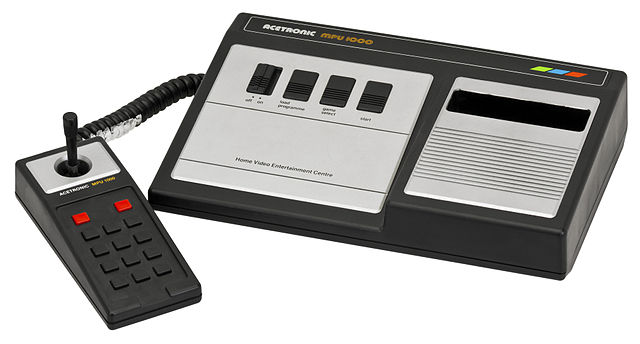

Released in 1978, the Acetronic MPU 1000 was one of the first home video game consoles produced by the German company Acetronic. Although overshadowed by other systems like the Atari 2600, the MPU 1000 holds a unique place in early gaming history. It was one of the early players in the home console market and boasted a solid game library despite its limitations.
Let's dive into the details of the Acetronic MPU 1000, exploring what made it stand out and why it didn't enjoy lasting success.
The Acetronic MPU 1000 was built to be a simple, functional console with a straightforward design. The console itself had a sleek, boxy shape and was lightweight, which was typical of consoles from the late 70s. Its grey plastic casing was unremarkable by modern standards but wasn't unattractive for the era. Its design was focused on utility, without any excess flair.
The controller was wired and had a limited button layout, with joystick-like functionality that allowed for basic movement or firing depending on the game being played. The design wasn't anything revolutionary, but it was ergonomically functional for the time. The console's simplicity made it an affordable option compared to other more complex systems of the time.
As with many consoles of its generation, the Acetronic MPU 1000 was powered by a simple microprocessor that enabled it to run a limited range of games. It was based on TTL (transistor-transistor logic) technology and could only handle basic graphics, which resulted in a more rudimentary experience when compared to later systems.
However, the system's performance was acceptable for the time. The graphics were simple monochrome shapes, and the sound was similarly basic-there was no real music or sound effects, just simple beeps and blips. Despite its humble technical abilities, the MPU 1000 could deliver fun and engaging gameplay for short sessions.
What made the Acetronic MPU 1000 interesting was its use of game cartridges. This allowed players to switch between games, which was a step up from more static consoles that only had built-in games. However, its hardware didn't allow for more complex or colorful games, which limited its appeal in an increasingly competitive market.
The Acetronic MPU 1000 came with a relatively small selection of games, with just a few cartridges available at launch. Some of the titles were pong-style games (reflecting the popularity of Pong at the time), while others were variations of tennis or shooter games. Most of the games involved simple two-player competitive gameplay, with a heavy emphasis on arcade-style action.
Notably, the MPU 1000's game library was not as diverse or expansive as other home consoles in the early days. Unlike the Atari 2600, which boasted a far larger catalog, the Acetronic MPU 1000 was limited by the capabilities of its hardware. While the basic game library provided some entertainment, it was easy to see why it struggled to compete with systems offering more advanced graphics and a larger game selection.
The simplicity of the games did have a certain charm-players could jump right into action without any steep learning curve. However, the lack of depth and variety in the games eventually made the MPU 1000 feel repetitive, and without new game releases or third-party support, interest in the console quickly waned.
The Acetronic MPU 1000 entered a competitive market, with major players like Atari already dominating the home gaming landscape. While its affordability and simplicity made it an attractive option for those looking for a budget-friendly console, it couldn't match the technological advancements or game libraries of its competitors.
One of the key drawbacks of the MPU 1000 was its lack of third-party developer support. The cartridge-based system had the potential to offer a larger library, but without significant backing from developers, it never truly took off. As other companies-like Atari and Mattel-offered more sophisticated systems, the Acetronic MPU 1000 faded into obscurity.
Although it didn't have the same lasting impact as some of its contemporaries, the Acetronic MPU 1000 did play a small but important role in the early days of home gaming consoles. It helped pave the way for future cartridge-based systems and provided a glimpse of the gaming future to come, even if it was eclipsed by better-known systems.
Limited Game Library: With only a handful of games available for the console, the MPU 1000 quickly ran out of content to keep players engaged long term.
Basic Graphics & Sound: The monochrome graphics and simplistic sound effects couldn't compete with the more visually advanced consoles that followed, making it feel outdated quickly.
Lack of Third-Party Support: The MPU 1000 was limited by the lack of games from other developers, meaning it didn't have the depth needed to maintain interest.
Short-Lived Impact: Despite being one of the early cartridge-based consoles, the Acetronic MPU 1000 was quickly overshadowed by the larger, more successful players in the market, like the Atari 2600.
The Acetronic MPU 1000 was a simple and affordable early console that offered an interesting concept in its cartridge-based design. However, its basic graphics, limited game library, and lack of third-party support ultimately prevented it from competing with the more successful systems of its time.
For collectors or retro gaming enthusiasts, the MPU 1000 provides an interesting glimpse into the early home console market, but for most players, its limited appeal and repetitive gameplay make it a niche curiosity rather than a must-have item. It's an important part of gaming history, but one that didn't quite live up to its potential in terms of lasting impact.
? A simple and affordable console with an interesting concept, but lacking the depth, game library, and technical advancements needed to compete with its contemporaries.